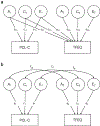Genetic and environmental influences on posttraumatic stress disorder symptoms and disinhibited eating behaviors
- PMID: 33404377
- PMCID: PMC8257777
- DOI: 10.1080/10640266.2020.1864587
Genetic and environmental influences on posttraumatic stress disorder symptoms and disinhibited eating behaviors
Abstract
Posttraumatic stress disorder (PTSD) and eating disorders (ED) frequently co-occur, but the mechanisms underlying this association remain unclear. EDs are characterized by features of maladaptive eating behaviors including disinhibited eating and cognitive dietary restraint. Identifying the genetic overlap between PTSD symptoms and maladaptive eating behaviors may elucidate biological mechanisms and potential treatment targets. A community sample of 400 same-sex twins (102 monozygotic and 98 dizygotic pairs) completed the PTSD Checklist-Civilian (PCL-C) for PTSD symptoms and the Three-Factor Eating Questionnaire-Reduced (TFEQ-R18) for eating behaviors (uncontrolled eating, emotional eating, and cognitive dietary restraint). We used biometric modeling to examine the genetic and environmental relationships between PCL-C and TFEQ-R18 total and subscales scores. Heritability was estimated at 48% for PTSD symptoms and 45% for eating behavior overall. Bivariate models revealed a significant genetic correlation between PTSD symptoms and eating behavior overall (rg =.34; CI:.07,.58) and Uncontrolled Eating (rg =.53; CI:.24,.84), and a significant environmental correlation between PTSD symptoms and Emotional Eating (re =.30; CI:.12,.45). These findings suggest the influence of common etiology. Future research and clinical efforts should focus on developing integrated treatments.
Figures

References
-
- Allison PD (2003). Missing data techniques for structural equation modeling. Journal of Abnormal Psychology, 112(4), 545–557. http://psycnet.apa.org/journals/abn/112/4/545/ - PubMed
-
- American Psychiatric Association. (2000). Diagnostic and statistical manual of mental disorders (4th ed., text rev.). Washington, DC: Author.
-
- Anderson LM, Reilly EE, Schaumberg K, Dmochowski S, & Anderson DA (2016). Contributions of mindful eating, intuitive eating, and restraint to BMI, disordered eating, and meal consumption in college students. Eating and Weight Disorders-Studies on Anorexia, Bulimia and Obesity, 21(1), 83–90. - PubMed
-
- Braun J, El-Gabalawy R, Sommer JL, Pietrzak RH, Mitchell K, & Mota N (2019). Trauma exposure, DSM-5 posttraumatic stress, and binge eating symptoms: Results from a nationally representative sample. The Journal of clinical psychiatry, 80(6). - PubMed
MeSH terms
Grants and funding
LinkOut - more resources
Full Text Sources
Other Literature Sources
Medical
